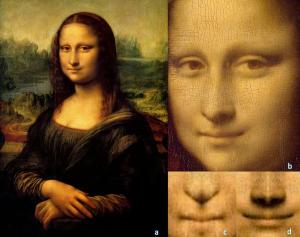-
The truth about the world’s most famous smile
Q. What’s the difference between the Mona Lisa smile and the MonaLisa Twins smile?
A. The MonaLisa Twins smile is the real deal!
This is an article from John Elder in The NEWDAILY (Australia).
“The surprising secret about the Mona Lisa that’s taken centuries to reveal
She was faking it all along:
Researchers from the University of Cincinnati accuse the model in da Vinci’s painting of lying.
For a number of years, there’s been a rumour that the Mona Lisa – the version sitting in the Louvre in Paris – is actually a fake.
Now, US and Italian researchers say they have evidence that Lisa Gherardini del Giocondo, wife of a Florentine slave trader, was faking it with that famous, enigmatic smile when she sat for the Leonardo da Vinci portrait that made her immortal.
How do they know this?
For a start, says University of Cincinnati neurologist Luca Marsili, there is no upper-face muscle activation in the Mona Lisa painting.A genuine smile, says Dr Marsili, lead author of the study, “causes the cheeks to raise and muscles around the eyes to contract,” and is called a Duchenne smile, after 19th-century French neurologist Guillaume Duchenne.
La Gioconda – as the Mona Lisa is also known, and which roughly, ironically translates as happy and jocular – has an asymmetric smile, or a non-Duchenne smile, which “reflects a non-genuine emotion and is thought to occur when the subject lies”.
How did they know hers was an asymmetrical smile?
Dr Marsili and his colleagues asked 42 people to judge which of six basic emotions were expressed by two chimeric images of the left and right sides of Mona Lisa’s smile.A chimeric image is a mirror image of just one side of the smile.
 \
\A: The Mona Lisa by Leonardo da Vinci (Musee du Louvre, Paris). B: The face of Mona Lisa C: Chimeric image of the left side of the Mona Lisa smile. D: Chimeric image of the right side of the Mona Lisa smile. Images: University of Cincinnati
Thirty-nine, or 92.8 per cent, of the volunteers indicated the left half of the smile displayed happiness, while none indicated the right side showed happiness.
Instead, 35 said the expression was neutral, five said it was disgust and two indicated sadness.
“Our results indicate that happiness is expressed only on the left side. According to some influential theories of emotion neuropsychology, we here interpreted the Mona Lisa asymmetric smile as a non-genuine smile, also thought to occur when the subject lies,” the authors write in their study published recently in Cortex.
None of this means Lisa was a font of dark deception
As the researchers write: “Considering it is unlikely that a person who sits motionless for hours to be painted is able to constantly smile in genuine happiness, the simplest explanation is that the Mona Lisa asymmetric smile is the manifestation of an ‘untrue enjoyment’ in spite of all the efforts that Leonardo’s jesters used to make in order to keep his models merry.”Dr Marsili and colleagues offer an alternative “intriguing” possibility: That da Vinci already knew the true meaning of an asymmetric smile more than three centuries before Duchenne’s analysis and deliberately illustrated a smile expressing a non-felt emotion.
If da Vinci was aware of the meaning of an asymmetric smile, the authors speculate that Mona Lisa‘s smile “might hide cryptic messages, for example, that this was in reality a self-portrait or that the portrait referred to a man or a dead woman.”
Three years ago, art historian Silvano Vinceti – following infrared analysis of the painting suggested da Vinci’s masterpiece is an amalgamation of two models: Lisa Gherardini, and da Vinci’s apprentice Gian Giacomo Caprotti, known to the artist as Salai, or Little Devil.”

Log in to reply.

